Art and nature are often so closely intertwined that distinguishing them is impossible. While this might seem obvious when it comes to landscapes, this is equally true of abstract art. “I don’t paint nature, I am nature,” said Jackson Pollock in response to Hans Hofmann’s critical jab that Pollock should paint scenes based on the natural world.
Many dismissed Abstract Expressionist works like Pollock’s as merely avant-garde explosions of color, and yet these artists also found inspiration in the flora and fauna of the world around them, though this was only recognized after the movement’s peak. In 1958, the exhibition “Nature in Abstraction” at the Whitney Museum of American Art challenged the limited view of abstract art, arguing that nature’s influence was fundamental to Abstract Expressionism.
Nonetheless, that exhibition was limited in its own way, ignoring women artists from the movement, such as Joan Mitchell, Lee Krasner, and Grace Hartigan, who were conspicuously absent. Today, a new version of this narrative is being planted at the Metropolitan Museum of Manila in the Philippines, where “Wild: Women Abstractionists on Nature,” on view through June 22nd, spotlights 34 women artists working to capture the beauty of nature in abstract form.
“Women have long been associated with nature and the environment, and with ‘Wild,’ I wanted to highlight the lasting impact of nature as inspiration through abstract works by these women artists,” said Kathy Huang, the show’s curator. “The difference now is that it has become increasingly more common to be someone of the diaspora, fusing visual references from a collection of places one might consider home.”
As contemporary women artists continue to build on the legacy of nature-inspired abstraction, for our increasingly international world, we explore the work of 10 women artists whose abstract work explores the beauty of the earth.
SARAH CUNNINGHAM
B. 1993, Nottingham, Anh
Lives and works in London
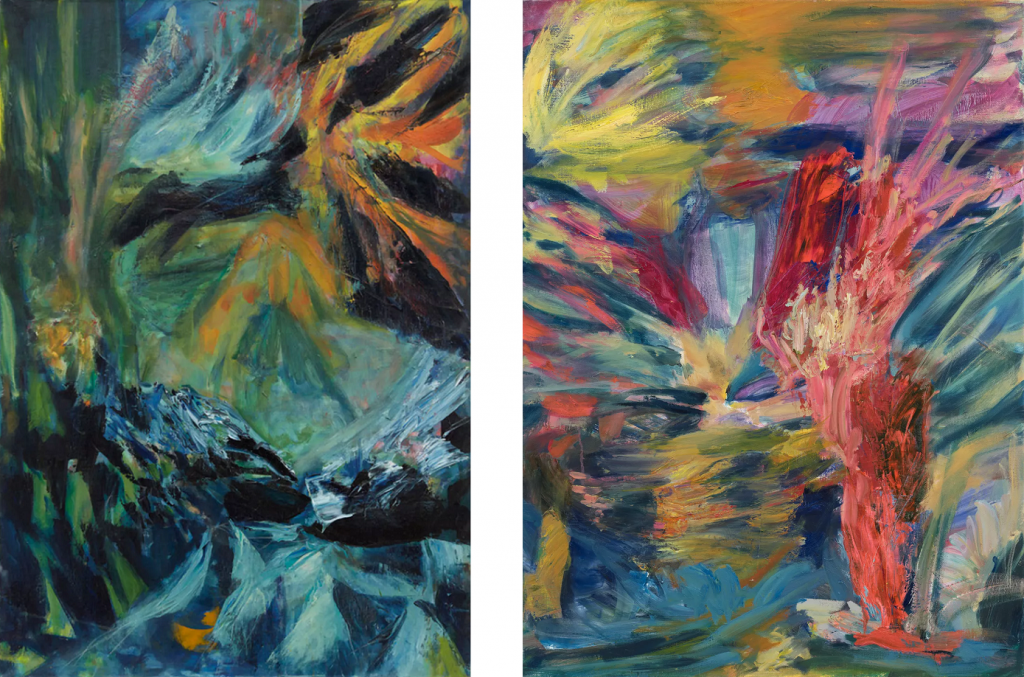
Left: Sarah Cunningham, Crystal forest, 2023. Right: Sarah Cunningham, Sea change, 2021.
Sarah Cunningham creates ethereal, kaleidoscopic abstractions where swathes of blue, green, yellows, and reds evoke natural phenomena, echoing sunsets, dense forests, mountainscapes, and the restless ocean. Raised in Nottingham, England, a city bordered by woodlands, Cunningham nurtured her bond with nature early on. “The way you ontologically separate these things—animal, human, tree—I’ve always found that way of thinking problematic,” Cunningham said in her Artsy Vanguard 2023–2024 interview.
Cunningham studied fine art at Loughborough University before receiving her MA in painting at the Royal College of Art in 2022. Now, at 30, Cunningham is represented by Lisson Gallery, which hosted her solo show “The Crystal Forest” in London last November. Her work is currently being shown at the gallery’s group exhibition “Accordion Fields.”
Jadé Fadojutimi
B. 1993, London
Lives and works in London

Jadé Fadojutimi, The Woven Warped Garden of Ponder, 2021. Courtesy of Christie’s Images Ltd. 2024.
Nigerian British painter Jadé Fadojutimi’s abstract canvases burst with bright colors and dynamic, feverish brushstrokes, crafting what she calls “emotional landscapes” that navigate the terrain between the internal psyche and the external natural world.
In her layered canvases, the artist captures the intoxicating qualities of nature. This is epitomized in The Woven Warped Garden of Ponder (2021), a luminously bright natural scene at massive scale, adorned by fragile, miniscule movements and details, which recently broke the artist’s auction record when it sold for £1.6 million ($2 million) at Christie’s.
Fadojutimi, the youngest artist to have a painting acquired by the Tate, is represented by leading galleries such as Gagosian, Galerie Gisela Capitain, and Taka Ishii Gallery.
Antonia Kuo
B. 1987, New York
Lives and works in Brooklyn
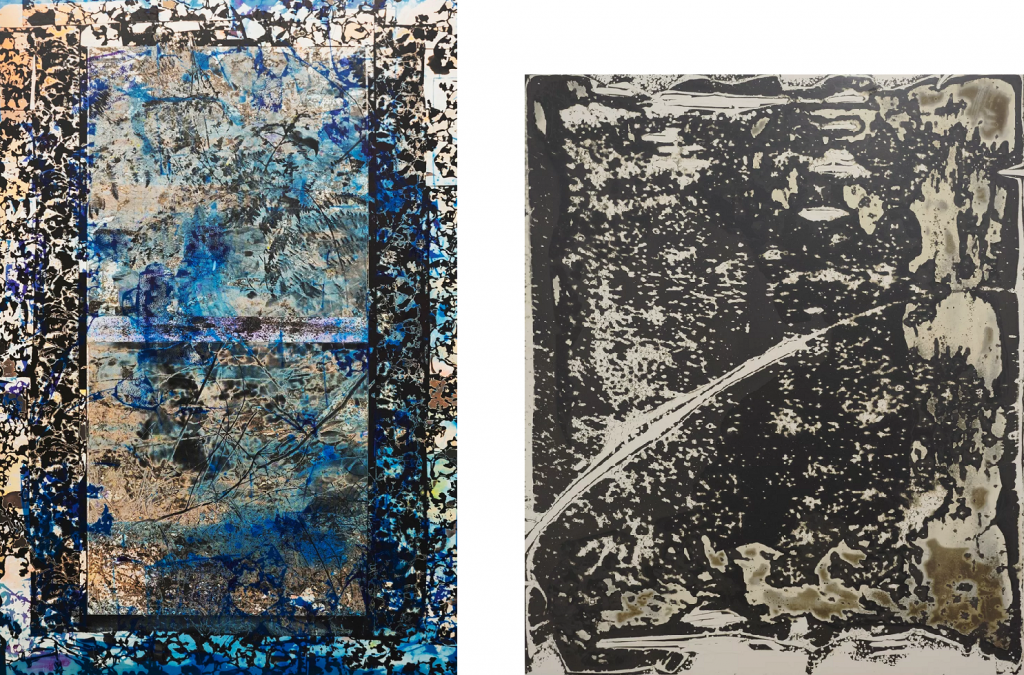
Left: Antonia Kuo, In stereo, 2022. Right: Antonia Kuo, Filament, 2021
Antonia Kuo has developed a technique for photochemical paintings where she manipulates light-sensitive paper and photo chemicals to create intricate abstractions while still using traditional drawing and painting methods.
Her two-panel chemigram Fugue (2023) is made up of a smaller top panel depicting pink wraithlike forms akin to lines of a topographic map and a larger bottom panel evocative of a valley at night illuminated by an iridescent glow. Kuo’s experimental works channel her intrinsic connection with the world around her.
Chapter NY announced its representation of the artist in April 2023. She is featured in “Wild: Women Abstractionists on Nature” at the Museum of Modern Art in Manila, and in May 2024, Kuo’s work will be featured in a group exhibition at Project Native Informant in London. Following this, in June 2024, Kuo will present a dual exhibition with Martin Wong at the Frye Art Museum in Seattle.
Lilian Thomas Burwell
B. 1927, Washington, D.C
Lives and works in Washington, D.C.
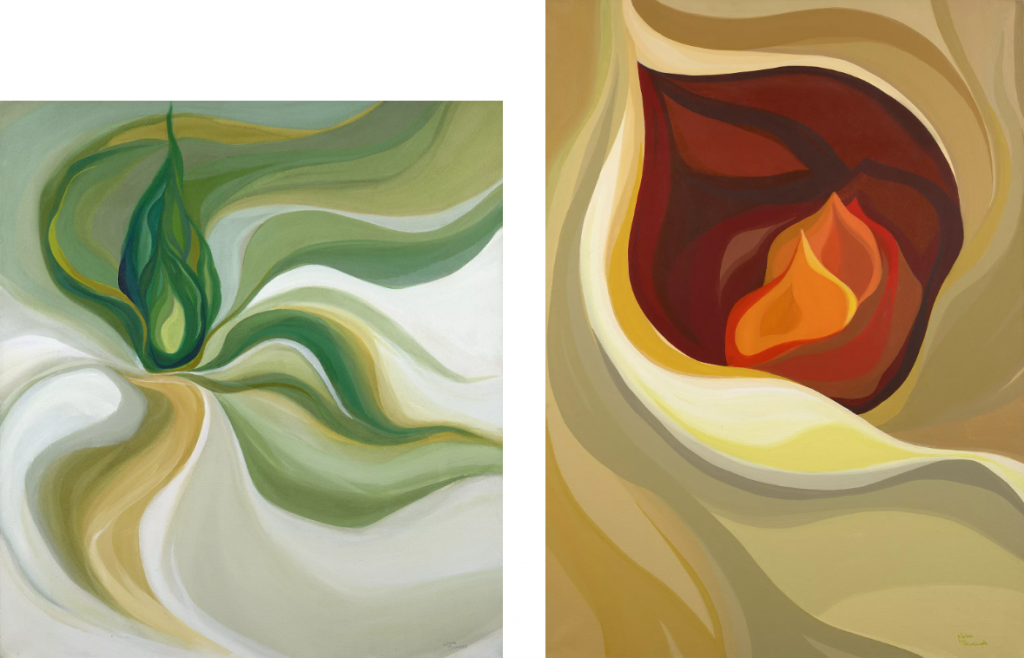
Left: Lilian Thomas Burwell, Joy, 1980. Right: Lilian Thomas Burwell, Earthbound, 1972.
The 96-year-old painter and sculptor Lilian Thomas Burwell often devotes herself to her garden. “That’s where I got my inspiration from: my involvement in gardening,” the artist said in a video for her 2021 New York solo debut, “Soaring,” presented by her representing gallery Berry Campbell.
Having studied at Pratt Institute and further honed her craft in Washington, D.C., in the studio of Abstract Expressionist Benjamin Abramowitz, the artist captures the essence of the organic world, translating the sinuous patterns and vibrant colors of her garden into harmonious paintings, which evoke cropped images of flowers and plants.
Her painting Joy (1980), for instance, showcases a leafy-green bud with flexuous brushstrokes spilling out into the edge of the canvas, depicting a microscopic view of plant life. Meanwhile, her sculptures, such as Montagne (2012), turn the vivid, incandescent hues of a natural landscape into a broken shard-like form. The nonagenarian has seen a string of shows recently, including a 2023 solo show at Berry Campbell Gallery entitled “Enfolded.”
Marina Rheingantz
B. 1983, Araraquara, Brazil
Lives and works in São Paulo
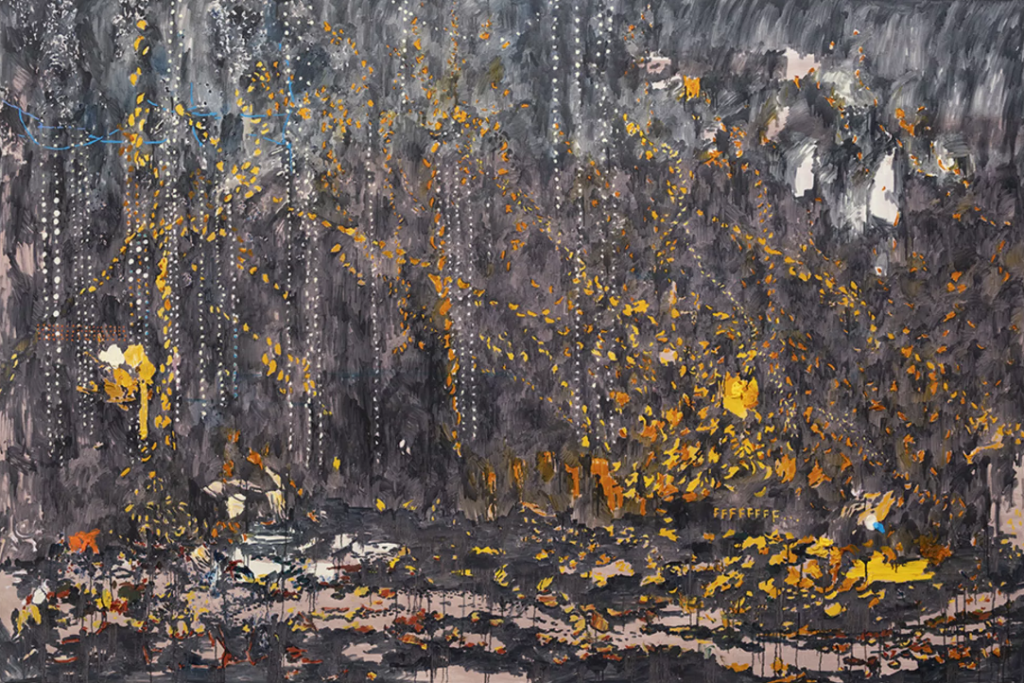
Marina Rheingantz, Fffffff, 2018
Marina Rheingantz draws on her memory of her Brazilian homeland to create semi-abstract paintings, picturing the vast terrains of oceanside cliffs, forestscapes, mountain ranges, and desert wastelands.
Raised in Araraquara, in the heart of Brazil’s countryside, Rheingantz has retained a connection to the environment and, through her textural and expansive works, attempts to reconstruct their ephemeral qualities. Ffffffff (2018), for example, portrays a gray, mountainous terrain accented with vivid splashes of orange and yellow, encapsulating nature in a state of flux.
Educated in fine arts at Fundação Armando Alvares Penteado in São Paulo, Rheingantz is represented by White Cube and Fortes D’Aloia & Gabriel. Residing and working in São Paulo, Rheingantz experienced a meteoric rise in 2023, with her solo show debut “Maré” at White Cube and record-breaking auction sales last March.
Christine Ay Tjoe
B. 1973, Bandung, Indonesia
Lives and works in Bandung
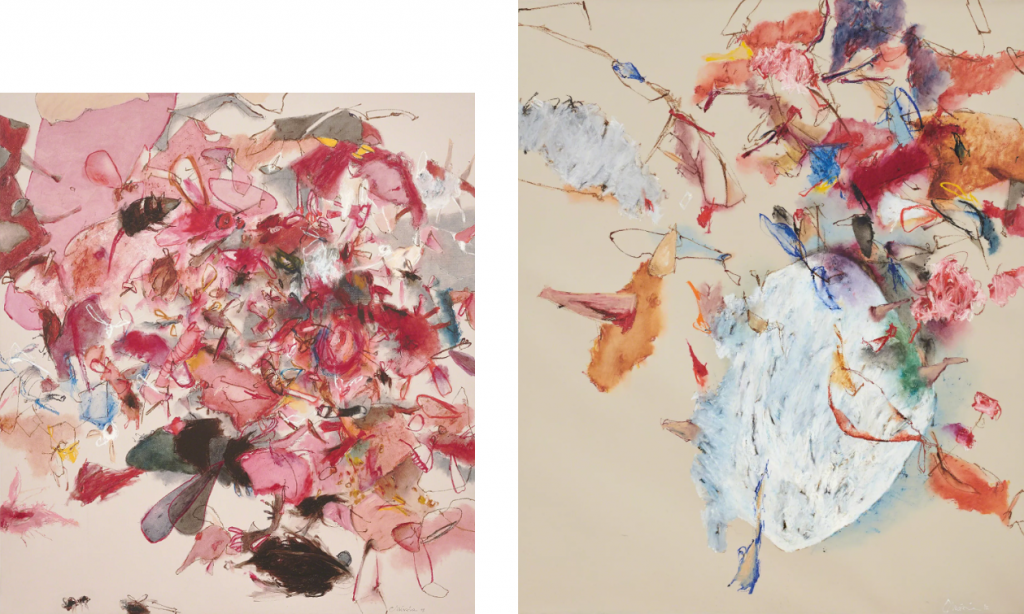
Left: Christine Ay Tjoe, Small flies and other wings, 2013. Right: Christine Ay Tjoe, … to see the White Land, 2012.
Following her childhood in the bustling center of Bandung, Indonesia, Christine Ay Tjoe moved to the lush, tree-filled outskirts of the city. Ay Tjoe’s love for the tropical terrain of her home country is palpable in her abstract paintings, where silhouettes of flora and fauna are depicted in dramatic, distorted sweeps of color.
In Small Flies and Other Wings (2013), a painting of reds, pinks, and blues, Ay Tjoe evokes the floral abstractions of Joan Mitchell. Meanwhile, her “Blue Cryptobiosis” series (shown in the 2021 exhibition “Spinning in the Desert” at White Cube Hong Kong) draws inspiration from the dormant states that organisms enter during extreme environmental conditions. These paintings, with their sweeping strokes of blue and red, represent floral forms that embody resilience in the face of adversity. Ay Tjoe’s paintings evoke the enduring splendor of nature, even as it faces the burgeoning threats of the environmental crisis.
Ay Tjoe began her career as a graphic designer, studying graphic design and printmaking at the Bandung Institute of Technology. At White Cube Mason’s Yard, the artist presented a solo exhibition, “Lesser Numerator,” from November 2023 to January 2024.
Elizabeth Neel
B. 1975, Stowe, Vermont
Lives and works in New York
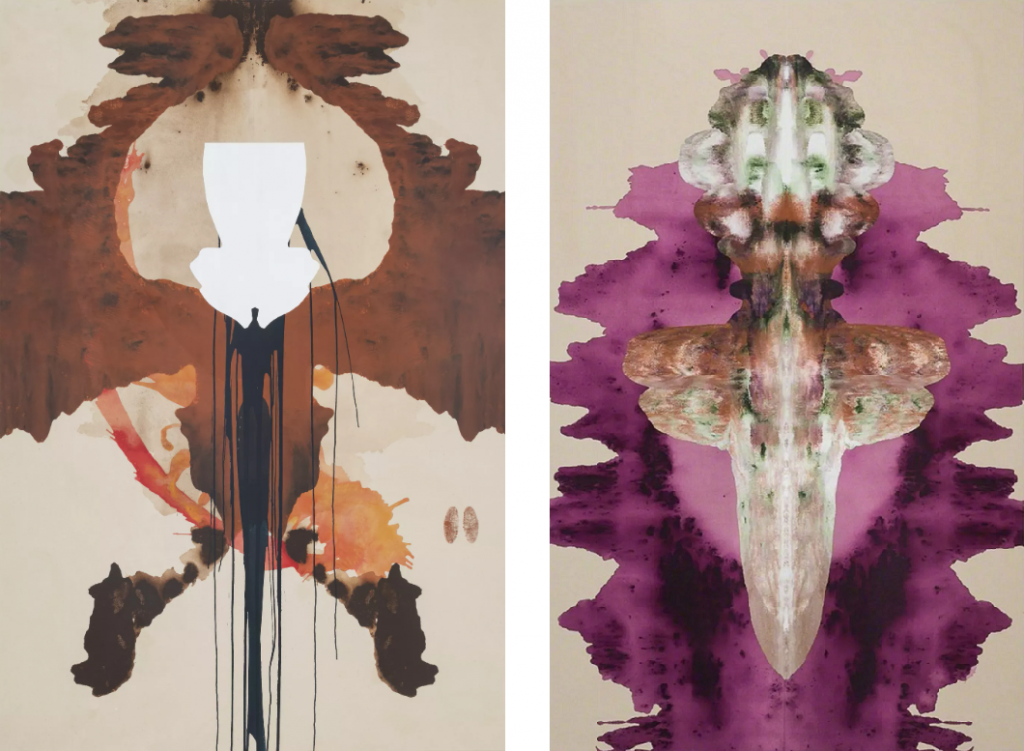
Left: Elizabeth Neel, Herald, 2019. Right: Elizabeth Neel, First man in Situ, 2016.
As the granddaughter of portraitist Alice Neel, Elizabeth Neel continues in her relative’s painterly footsteps. However, unlike her grandmother, Elizabeth Neel explores humans’ relationship with the natural world through abstraction, inspired by various references culled from the internet, television, and other archives.
Neel, who is represented by Pilar Corrias Gallery, is known for her turbulent, even violent canvases, several of which (like Herald, 2019, and First Man in Situ, 2016) explore the bilateral symmetry that occurs within many living organisms, often resembling chromatic Rorschach tests.
Through her abstractions, Neel also probes the impact of human interference in the natural world. For instance, in Swamp Dump (2005), a painting inspired by a 1996 plane crash in the Florida Everglades, the artist portrays the man-made wreckage in one of the least human-populated sites in the United States.
Dawn Ng
B. 1982, Singapore
Lives and works in Singapore
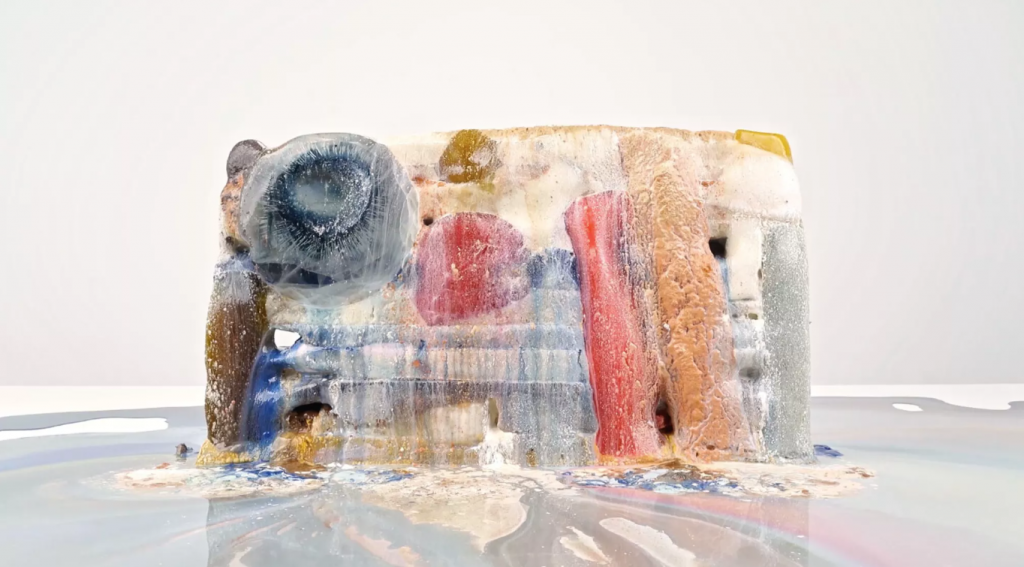
Dawn Ng, Avalanche III, 2022
Singaporean artist Dawn Ng is fascinated by ice. “To me, ice is the perfect material precisely because it cannot last. If you think about the truth that from the moment we are born, we start to die—then ice yields to that law of nature in the most acute, condensed splendor,” Ng said in an interview with Tatler Asia.
In Ng’s series “Into Air” (2018–present), most recently presented by her representing gallery, Sullivan+Strumpf, in 2022, photographs and films show melting blocks of colored ice. This multi-year project encourages viewers to adopt a slow perspective when looking at the work, reminding the viewer of the ephemerality of life. In her textural paintings, meanwhile, Ng explores how nature’s patterns can be translated into abstract forms. For instance, The Earth Laughs in Flowers I (2021), characterized by fraught blue brushstrokes and subtle yellow blotches, portrays her idea of natural growth, depicted as a singular line sprouting from the center, vibrant and resilient.
Sara Jimenez
B. 1984, London, Canada
Lives and works in New York
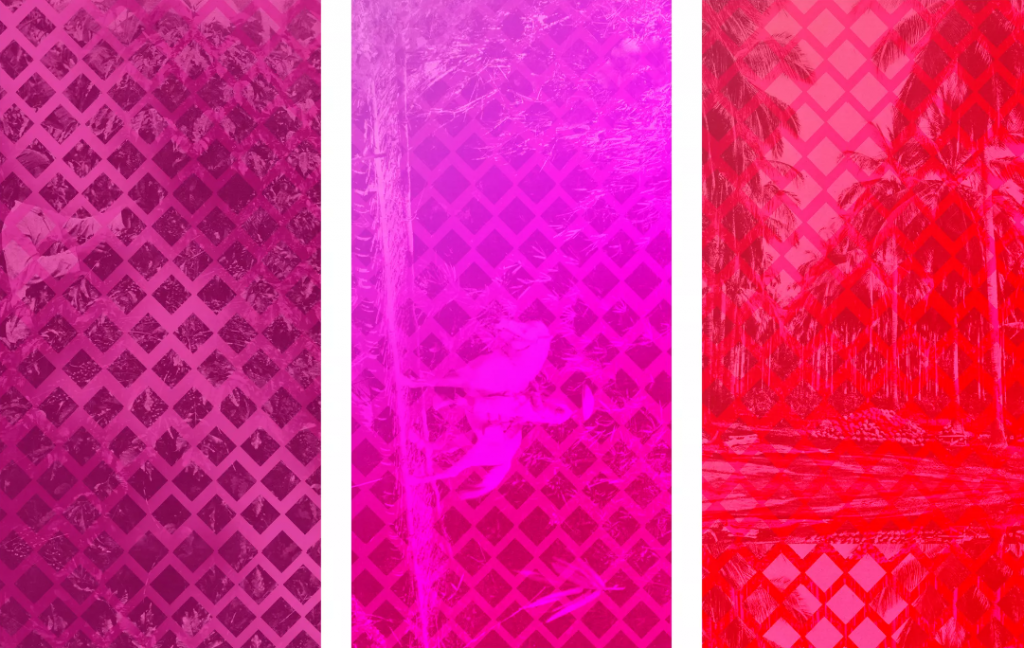
Sara Jimenez, Tropical Bounds (Triptych), 2018
Sara Jimenez draws on her Filipino heritage by transforming archival colonial American photographs of the Philippines into abstract landscapes. Her works, such as Tropical Bounds (Triptych) (2018), often use vibrant color overlays and lattice designs on historical photographs to disrupt colonial control of the landscapes; Instead of these typical depictions, she invites viewers to reconsider the past from a new, fresh perspective.
Likewise, in her installation works, Jimenez incorporates a tactile approach to nature. At what point does the world unfold? (2022), presented at Cornell’s Arts Quad in 2022, comprises several pink fabrics pinned to trees and the field, imbuing textiles with botanical motifs as a reminder of the significance of the natural environment for our cultural identity and collective memory.
Since graduating from the University of Toronto and Parsons School of Design, Jimenez has presented her work in solo exhibitions at MadArt, Morgan Lehman Gallery, and Rachel Uffner Gallery.
Diana Al-Hadid
B. 1981, Aleppo, Syria
Lives and works in New York
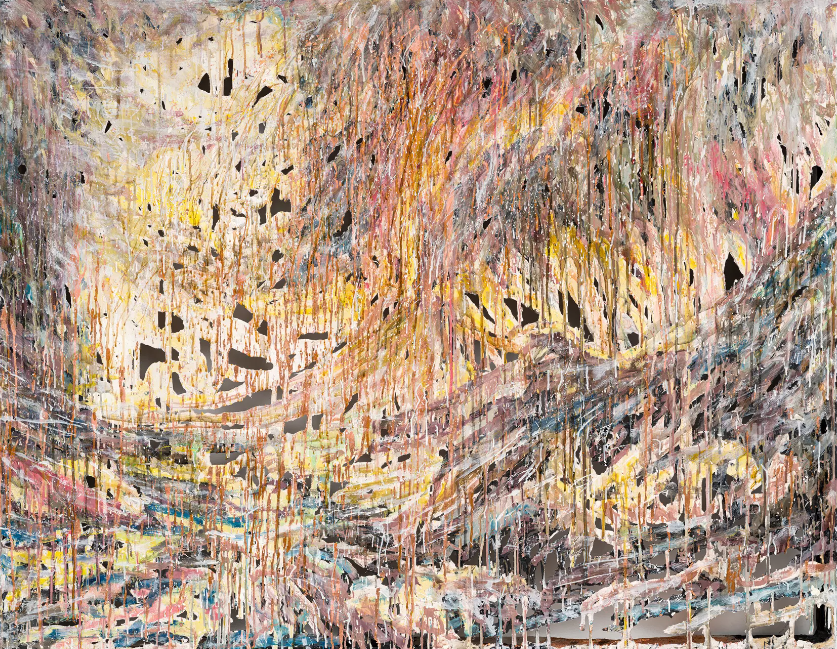
Diana Al-Hadid, Hot head, 2022
Concrete, metal, cardboard, paper, and fiberglass: These are the everyday materials through which Syrian artist Diana Al-Hadid sculpts her enigmatic forms and architectural installations. Al-Hadid’s abstract, frenetic wall works draw inspiration from the geological formations and natural forms—mountains, flowers, and caves—she encountered during her childhood in the Middle East.
For instance, Hot Head (2022), a bright landscape made from polymer gypsum, fiberglass, steel, gold leaf, and pigment, resembles a volcanic eruption. She creates images of landscapes that seem to be in a state of flux, melting away before the viewer’s eyes.
Represented by Kasmin, Al-Hadid presented her debut solo exhibition with the gallery, “Women, Bronze, and Dangerous Things,” in 2023. Here, she used natural representations to explore the immigrant experience with Warda (2023), a delicate yet somber bronze sculpture of a lone-rooted white jasmine flower representing the immigrant narrative of being uprooted and seeking growth in new soil.
Written by Maxwell Rabb
Source: Artsy







